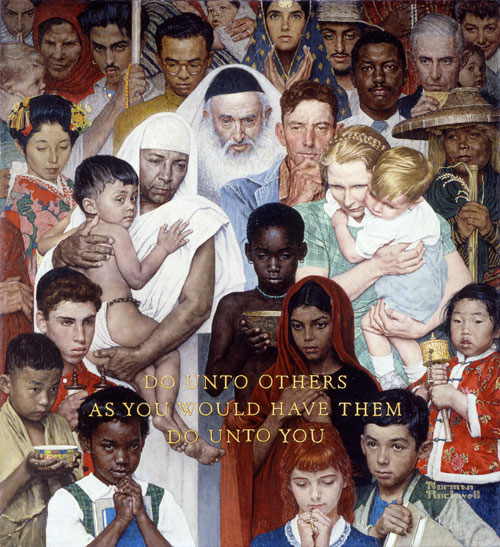

Golden Rule, 1961
In the 1960s, the mood of the country was changing, and Norman Rockwell's opportunity to be rid of the art intelligentsia's claim that he was old-fashioned was on the horizon. His 1961 Golden Rule was a precursor to the type of subject he would soon illustrate. A group of people of different religions, races, and ethnicity served as the backdrop for the inscription "Do Unto Other as You Would Have Them Do Unto You." Rockwell was a compassionate and liberal man, and this simple phrase reflected his philosophy. Having traveled all his life and been welcomed wherever he went, Rockwell felt like a citizen of the world, and his politics reflected that value system.
I'd been reading up on comparative religion. The thing is that all major religions have the Golden Rule in common. "Do unto others as you would have them do unto you." Not always the same words but the same meaning.
-Norman Rockwell, The Norman Rockwell Album.
From photographs he'd taken on his 1955 round-the-world Pam Am trip, Rockwell referenced native costumes and accessories and how they were worn. He picked up a few costumes and devised some from ordinary objects in his studio, such as using a lampshade as a fez. Many of Rockwell's models were local exchange students and visitors. In a 1961 interview, indicating the man wearing a wide brimmed hat in the upper right corner, Rockwell said, "He's part Brazilian, part Hungarian, I think. Then there is Choi, a Korean. He's a student at Ohio State University. Here is a Japanese student at Bennington College and here is a Jewish student. He was taking summer school courses at the Indian Hill Museum School." Pointing to the rabbi, he continued, "He's the retired postmaster of Stockbridge. He made a pretty good rabbi, in real life, a devout Catholic. I got all my Middle East faces from Abdalla who runs the Elm Street market, just one block from my house." Some of the models were from Rockwell's earlier painting United Nations. Though it was never finished, it was going to be a "a mass of people," he said, "representing the people of the world, waiting for the delegates to straighten out the world, so that they might live in peace and without fear."
Golden Rule, Norman Rockwell, 1961.
Oil on canvas, 44½" x 39½".
Cover illustration for The Saturday Evening Post, April 1, 1961.
From the permanent collection of Norman Rockwell Museum.
Golden Rule (study), Norman Rockwell, 1961.
Reference photos for Golden Rule by Louie Lamone, 1961.